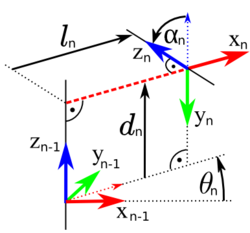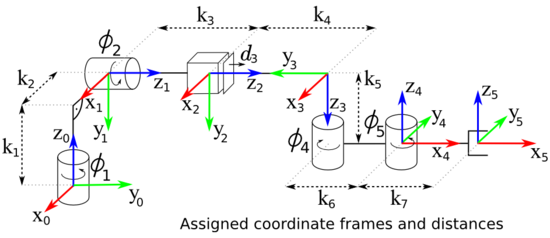Difference between revisions of "Denavit-Hartenberg parameters"
| Line 56: | Line 56: | ||
The angle <math>\alpha_n</math> corresponds to the angle about the [[Common normal|common normal]] to align the <math>z_{n-1}</math>-axis with the new <math>z_{n}</math>-axis | The angle <math>\alpha_n</math> corresponds to the angle about the [[Common normal|common normal]] to align the <math>z_{n-1}</math>-axis with the new <math>z_{n}</math>-axis | ||
|} | |} | ||
| + | |||
;[[File:Hint.png|10px]] '''<span style="color:#ff0000">Special case</span>''' | ;[[File:Hint.png|10px]] '''<span style="color:#ff0000">Special case</span>''' | ||
| + | :[[File:dh-params-specialcase.png|right|200px]] | ||
:It can occur that there is an offset ... | :It can occur that there is an offset ... | ||
Revision as of 17:27, 16 November 2015
| ← Back: Assigning coordinate frames | Overview: Denavit-Hartenberg Convention | Next: A-matrices → |
When the coordinate frames are assigned to a manipulator, the transformation between each two consecutive frames has to be described. As before for the assignment of the coordinate frames, the manipulator has to be in its zero position as well for the determination of the parameters. The figure on the right shows the two coordinate frames  and
and  in their zero position and the corresponding common normal represented by a dashed red line. To describe the transformation of
in their zero position and the corresponding common normal represented by a dashed red line. To describe the transformation of  with respect to
with respect to  , the 4 Denavit-Hartenberg parameters
, the 4 Denavit-Hartenberg parameters  ,
,  ,
,  and
and  are used. These parameters describe the static transformation within link
are used. These parameters describe the static transformation within link  , but as well include the dynamic influence of the joint parameter of
, but as well include the dynamic influence of the joint parameter of  , that could change over time. The figure illustrates the parameters, that are defined as follows:
, that could change over time. The figure illustrates the parameters, that are defined as follows:

|
The angle
| ||||

|
| ||||

|
The parameter If the related joint | ||||

|
The angle |
The 4 parameters can rather be determined by just regarding the two coordinate frames, their axes and the common normal like visualized above. To completely understand the parameters and their meaning, the figure below illustrates what the parameters actually describe.  ,
,  ,
,  and
and  define 4 transformations that are applied consecutively to transform the coordinate frame
define 4 transformations that are applied consecutively to transform the coordinate frame  to
to  . First a rotation about the
. First a rotation about the  -axis by
-axis by  is applied followed by a translation along it by
is applied followed by a translation along it by  . Then the coordinate frame is rotated about the
. Then the coordinate frame is rotated about the  -axis by
-axis by  . Finally a translation along the
. Finally a translation along the  -axis leads to the next coordinate frame
-axis leads to the next coordinate frame  . Some further aspects about the meaning and the use of the 4 parameters are described in the following article about the A-matrices.
. Some further aspects about the meaning and the use of the 4 parameters are described in the following article about the A-matrices.
The video at the end of this page explains the assignment of the coordinate frames and the determination of the 4 parameters very vividly and comprehensibly.
|
The table below contains the Denavit-Hartenberg parameters for the manipulator shown in the figure on the right. For further information about the already assigned coordinate frames, have a look on the examples of the previous articles. The necessary lengths of certain parts of the manipulator are indicated by the variables
|
Multimedial educational material
|
https://www.youtube.com/watch?v=qZB3_gKBwf8 Video: Assignment of coordinate frames and determination of the parameters (in German) |

 -axis.
-axis.

 ) has to be included in the Denavit-Hartenberg parameter
) has to be included in the Denavit-Hartenberg parameter  at the distal joint. The coordinate frames are shown in their zero position. The angle
at the distal joint. The coordinate frames are shown in their zero position. The angle  describes the rotation about the
describes the rotation about the  -axes.
-axes.


 is based on the geometric structure of the link and also valid in the zero position. The dynamic offset
is based on the geometric structure of the link and also valid in the zero position. The dynamic offset  corresponds to the joint parameter and so to the displacement of joint
corresponds to the joint parameter and so to the displacement of joint 
 , which corresponds to the complete offset along the
, which corresponds to the complete offset along the  .
.
 -axis
-axis







 to
to  .
.












